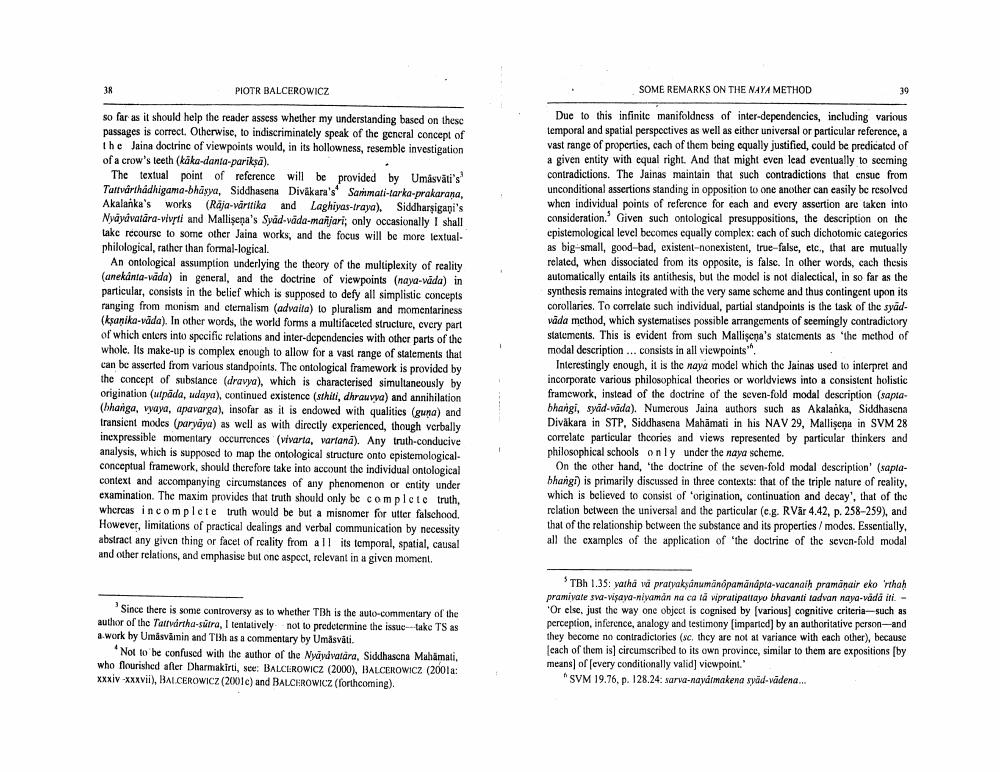Book Title: Some Remarks On The Naya Mmethod Author(s): Piotr Balcerowicz Publisher: Piotr Balcerowicz View full book textPage 2
________________ PIOTR BALCEROWICZ SOME REMARKS ON THE NAYA METHOD so far as it should help the reader assess whether my understanding based on these passages is correct. Otherwise, to indiscriminately speak of the general concept of the Jaina doctrine of viewpoints would, in its hollowness, resemble investigation of a crow's teeth (kaka-danta-pariksd). The textual point of reference will be provided by Umåsväli's! Tallvarthadhigama-bhayya, Siddhasena Divakara's Sarmati-tarka-prakarana, Akalanka's works (Raja-vartrika and Laghiyas-traya). Siddharşigani's Nyaydivatāra vivyti and Mallisena's Syad-voda-manjarl, only occasionally I shall take recourse to some other Jaina works, and the focus will be more lextual philological, rather than formal-logical. An ontological assumption underlying the theory of the multiplexity of reality (anekanta-vada) in general, and the doctrine of viewpoints (naya-vada) in particular, consists in the belief which is supposed to defy all simplistic concepts ranging from monism and clemalism (advaita) to pluralism and momentariness (ksanika-voda). In other words, the world forms a multifaceted structure, every part of which enters into specific relations and inter-dependencies with other parts of the whole. Its make-up is complex enough to allow for a vast range of statements that can be asserted from various standpoints. The ontological framework is provided by the concept of substance (dravya), which is characterised simultaneously by origination (utpada, udaya), continued existence (sthill, dhrauva) and annihilation (Ihanga, yaya, apavarga), insofar as it is endowed with qualities (guna) and transient modes (paryayu) as well as with directly experienced, though verbally inexpressible momentary occurrences (vivarta, varlana). Any truth-conducive analysis, which is supposed to map the ontological structure onto epistemological conceptual framework, should therefore take into account the individual ontological context and accompanying circumstances of any phenomenon or entity under examination. The maxim provides that truth should only be complete truth, whereas incomplete truth would be but a misnomer for utter falschood. However, limitations of practical dealings and verbal communication by necessity abstract any given thing or facet of reality from all its temporal, spatial, causal and other relations, and emphasise but onc aspect, relevant in a given moment. Due to this infinite manifoldness of inter-dependencies, including various temporal and spatial perspectives as well as either universal or particular reference, a vast range of properties, cach of them being equally justified, could be predicated of a given entity with equal right. And that might even lead eventually to seeming contradictions. The Jainas maintain that such contradictions that ensuc from unconditional assertions standing in opposition to one another can easily be resolved when individual points of reference for each and every assertion are taken into consideration. Given such ontological presuppositions, the description on the epistemological level becomes equally complex: cach of such dichotomic categories as big-small, good-bad, existent-nonexistent, true-false, etc., that are mutually related, when dissociated from its opposite, is falsc. In other words, each thesis automatically entails its antithesis, but the model is not dialectical, in so far as the synthesis remains integrated with the very same scheme and thus contingent upon its corollaries. To correlate such individual, partial standpoints is the task of the syadvada method, which systematises possible arrangements of seemingly contradictory statements. This is evident from such Mallisena's statements as the method of modal description ... consists in all viewpoints". Interestingly enough, it is the naya model which the Jainas used to interpret and incorporate various philosophical theories or worldviews into a consistent holistic framework, instead of the doctrine of the seven-fold modal description (saniabhangi, swid wida). Numerous Jaina authors such as Akalahku, Siddhasena Divakara in STP, Siddhasena Mahamati in his NAV 29, Mallisena in SVM 28 correlate particular theories and views represented by particular thinkers and philosophical schools only under the naya scheme. On the other hand, the doctrine of the seven-fold modal description' (saplabhangi) is primarily discussed in three contexts that of the triple nature of reality, which is believed to consist of origination, continuation and decay', that of the relation between the universal and the particular (e.g. RVär 4.42, p. 258-259), and that of the relationship between the substance and its properties / modes. Essentially all the cxamples of the application of the doctrine of the seven-fold modal Since there is some controversy as to whether Th is the auto-commentary of the author of the Tattvartha-sútra, I tentatively not to predetermine the issue-take TS as a work by Umaskin and Th as a commentary by Umásvali. Not to be confused with the author of the Nyuydvatara, Siddhascna Mahamati, who flourished after Dharmakirti, ser: BALCEROWICZ (2000), BALCEROWICZ (2001: XXXIV -xxxvii), BALCEROWICZ (2001e) and BALCHROWICZ (forthcoming). TBh 1.35: yarhad praryakyanuman pamanta-vucanaih pramanair eko thah pramivale sva-visaya nivad nu ca ta vpratipattayo bhavanti advan naya-vada iti. - 'Or else, just the way onc object is cognised by various cognitive criteria---such as perception, inference, analogy and testimony (imparted by an authoritative person-and they become no contradictories (sc. they are not at variance with each other), because each of them is circumscribed to its own province, similar to them are expositions [by means of every conditionally valid] viewpoint. SVM 19.76, p. 128.24: sarva-nav makena syd-vadena...Page Navigation
1 2 3 4 5 6 7 8 9 10 11 12 13 14 15 16 17
